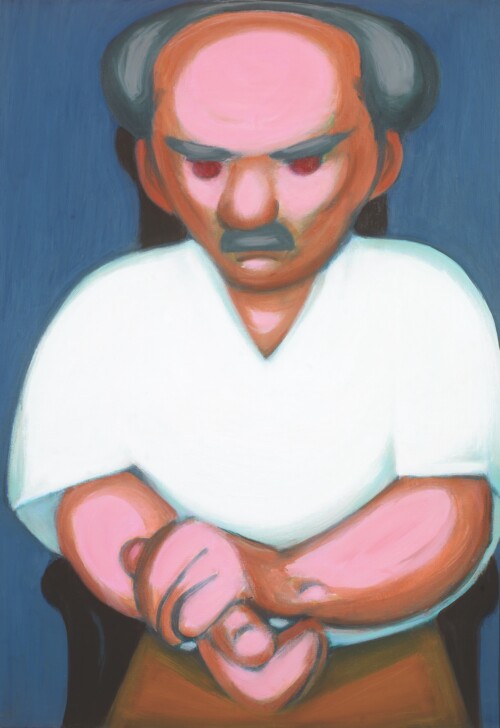| 29 |
Greek, 1914-1995
Portrait of an aged man
oil on canvas
100 x 70 cm
PROVENANCE
private collection, Athens
EXHIBITED
Diamantis Diamantopoulos, Works 1978-1980, Ora Cultural Centre, Athens, 3-15 November 1980
LITERATURE
Diamantis Diamantopoulos, Works 1978-1980, Ora Cultural Centre, Athens, 1980, no 22 (illustrated)
| 14 000 / 18 000 € | |
After living in isolation for almost twenty-five years, Diamantopoulos held a large-scale retrospective exhibition at the National Gallery, Athens in 1978. This was followed by a major solo exhibition, two years later, at the Ora Gallery in Athens, where his works provoked general astonishment, establishing him as one of the greatest artists of his generation.
Portrait of an aged man belongs to that body of work. His distinctive rounded shapes convey a sense of honesty and humility captured both in the facial characteristics and body posture, especially in the hands of the sitter. The third dimension is accentuated by the intermediate element of the armchair between the human figure and the monochromatic background. The infinite blue background dispenses with the renaissance notion of the painting as a window to the world.
Influenced from the broad, flatforms of Matisse, the cubism of Leger and the colours of Fauves, Diamantopoulos focused his full attention on his subject, dispensing with any superfluous detail. With great economy of line and colour, he portrayed ordinary people, endowing them with certain monumentality. As he once stated: "Painting must be an expression of your life and that of the people around you"
Diamantis Diamantopoulos was born in Magnesia, Asia Minor in 1914. In 1922 he moved to Athens with his family.
In 1931 he enrolled at the School of Fine Arts, Athens to study under Dimitrios Biskinis and Constantinos Parthenis, graduating in 1936. In 1934 while still a student he designed the stage set and costumes for the tragedy ‘Alcestis’ by Euripides directed by Karolos Koun. He travelled to Italy and France where he came in contact with contemporary movements of European art.
After a period of fairly intense artistic creativity during the 1940s, Diamantopoulos withdrew from the art world. For the next twenty-five years, he became a recluse and devoted himself to painting and writing, refusing to exhibit, sell or participate in any artistic activities.
He returned to the visual arts in 1975, with an exhibition at Ora Gallery, a major artistic event especially after the fall of the Greek military junta. Both his paintings and his views on art stirred great interest. In 1978 the National Gallery of Greece staged a large retrospective exhibition of his work that established him as one of the most important painters of his generation. Two more solo exhibitions followed at Ora gallery: one in 1980 and one in 1982. In 1982 he represented Greece at the Venice Biennale and in the same year, he participated at ‘Europalia’ in Belgium where he was exhibited among the masters of Greek Art.
His painting, usually anthropocentric, is characteristic of its drawing solidity, the dynamic compositions and the peculiar use of colour. His subject matter often refers to the working class, either realistically or symbolically. Both his work and his views towards art have caused a lot of debate creating a myth around him, centred at the undeniable quality of his work, his ideological, theoretical and psychological peculiarities and his tendency for seclusion.
Like other members of the ‘Thirties Generation’, Diamantopoulos developed a uniquely personal style, one that combined elements of European art with an aesthetic rooted in the traditions of Byzantine and Greek folk art, as well as of everyday Greek life.
His work is found in the National Gallery of Greece, the Municipal Gallery of Athens, the Municipal Gallery of Rhodes, the National Bank of Greece Cultural Foundation, the Leventis Gallery and many public and private collections.
